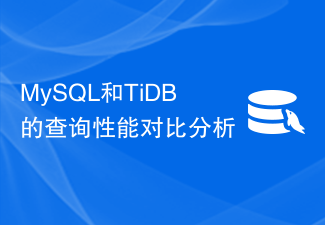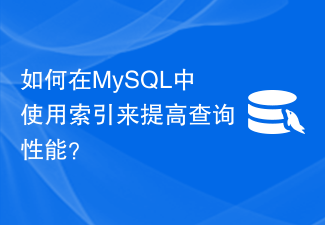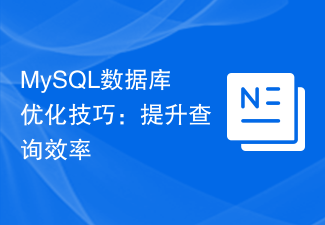 Backend Development
Backend Development PHP Tutorial
PHP Tutorial Design strategies for partitioned tables and horizontal partitioning of PHP and MySQL indexes and their impact on query performance
Design strategies for partitioned tables and horizontal partitioning of PHP and MySQL indexes and their impact on query performance
Design strategies for partitioned tables and horizontal sharding of PHP and MySQL indexes and their impact on query performance
Introduction:
When developing web applications , PHP and MySQL are powerful tools that are frequently used. When designing the database structure, the selection and use of indexes have a great impact on query performance. This article will focus on the design strategy of index partition tables and horizontal table partitions and their impact on query performance, and provide specific code examples.
1. Index partition table design strategy
1.1 What is a partition table?
A partition table divides a large table into multiple small partitions. Each partition is stored independently. The table data can be divided and stored according to specific conditions. The advantage of this is that it can improve query performance and speed up data retrieval.
1.2 Design strategy for partitioned tables
(1) Choose the appropriate partition key:
The partition key is the basis for dividing the table. It can be a column or a group of columns in the table. , commonly used partition keys include date, geographical location, etc. Appropriate partition keys can reasonably segment data and improve query performance. For example, if a table is partitioned by year, then when querying data for a certain year, the database only needs to query the data of that partition instead of scanning the entire large table, thereby improving query efficiency.
(2) Select the appropriate partition type:
MySQL provides a variety of partition types, including range partitioning, list partitioning, hash partitioning, etc. Choosing the appropriate partition type according to different business needs can improve query efficiency. For example, if you need to query based on a date range, you can choose range partitioning; if you need to query discretely based on the value of a certain column, you can choose hash partitioning.
(3) Reasonably set the number of partitions:
The number of partitions is determined based on the amount of data and query requirements. Too few partitions may result in low query efficiency, and too many partitions will increase management and query requirements. complexity. Properly setting the number of partitions can balance query performance and management costs.
2. Design strategy of horizontal sub-table
2.1 What is horizontal sub-table?
Horizontal table partitioning is to divide a large table into multiple small tables according to certain conditions, and each small table stores a part of the data. The advantage of this is to reduce the amount of data in a single table and improve query performance.
2.2 Design strategy for horizontal table sharding
(1) Select appropriate slicing conditions:
Appropriate slicing conditions can be determined according to business needs. For example, if you need to query based on user ID, you can divide the data into tables based on user ID; if you need to query based on region, you can divide the data into tables based on region.
(2) Reasonably set the number of sharded tables:
Same as partitioned tables, the number of horizontal sharded tables also needs to be determined based on the amount of data and query requirements. Too few shards may cause the data volume of a single table to be too large, and too many shards may increase management and query complexity.
(3) Use vertical table sharding to assist in improving query performance:
In addition to horizontal table sharding, vertical table sharding is also a strategy to improve query performance. Columns in a large table can be divided into different tables according to different business functions. This can reduce the amount of data during query and improve query efficiency.
3. The impact of indexes on query performance
Whether it is a partitioned table or a horizontal table, it is inseparable from the support of indexes. Indexes can improve query performance and speed up data retrieval. The following is the impact of indexes on query performance:
(1) Accelerate data retrieval: Indexes can sort and group large amounts of data, thereby speeding up queries.
(2) Reduce disk IO: The index can concentrate the queried data in one or a small number of disk blocks, reducing the number of disk reads and writes.
(3) Reduce system overhead: Indexes can improve query efficiency, reduce system load, and improve system performance.
4. Code Example
Taking the partition table as an example, a simple code example is given below:
CREATE TABLE `orders` (
`id` int(11) NOT NULL AUTO_INCREMENT,
`order_date` date NOT NULL,
`customer_id` int(11) NOT NULL,
`amount` decimal(10,2) NOT NULL,
PRIMARY KEY (`id`, `order_date`)
) ENGINE=InnoDB DEFAULT CHARSET=utf8
PARTITION BY RANGE (ORDER BY order_date)(
PARTITION p0 VALUES LESS THAN ('2020-01-01'),
PARTITION p1 VALUES LESS THAN ('2021-01-01'),
PARTITION p2 VALUES LESS THAN ('2022-01-01'),
PARTITION p3 VALUES LESS THAN (MAXVALUE)
);The above code creates a file named orders The partition table is range partitioned according to order_date. The partition table designed in this way can quickly query data based on the order date and improve query performance.
Conclusion:
In the development of PHP and MySQL, the selection and use of indexes have an important impact on query performance. Through reasonable design of partition table and horizontal table partitioning strategies, combined with appropriate indexes, query performance can be improved and data retrieval can be accelerated. In actual development, it is necessary to select appropriate partition keys, partition types, and segmentation conditions based on specific business needs and data scale. At the same time, pay attention to using vertical table partitioning to assist in improving query performance.
The above is the detailed content of Design strategies for partitioned tables and horizontal partitioning of PHP and MySQL indexes and their impact on query performance. For more information, please follow other related articles on the PHP Chinese website!
 MySQL和PostgreSQL:如何优化数据库查询性能?Jul 12, 2023 pm 03:15 PM
MySQL和PostgreSQL:如何优化数据库查询性能?Jul 12, 2023 pm 03:15 PMMySQL和PostgreSQL:如何优化数据库查询性能?概述:在开发应用程序时,数据库查询性能是一个重要的考虑因素。良好的查询性能可以提高应用程序的响应速度和用户体验。本文将介绍一些优化数据库查询性能的方法,重点涵盖MySQL和PostgreSQL两种常用数据库。数据库索引的优化:数据库索引是提高查询性能的重要因素。索引可以加快数据的查找速度,减少查询时扫
 Python优化MySQL连接查询性能的方法?Jun 30, 2023 am 11:27 AM
Python优化MySQL连接查询性能的方法?Jun 30, 2023 am 11:27 AM如何在Python程序中优化MySQL连接的查询性能?随着数据量的增加和业务需求的提升,数据库的性能在系统开发中变得越来越重要。MySQL作为最流行的关系型数据库之一,在Python程序开发中也被广泛使用。但是,如果不合理地使用MySQL连接和查询,可能会导致性能下降。本文将介绍一些优化MySQL连接的查询性能的方法。使用合适的索引:索引是提高查询性能的关键
 如何优化PHP的数据库连接和查询性能?Jun 29, 2023 am 10:25 AM
如何优化PHP的数据库连接和查询性能?Jun 29, 2023 am 10:25 AM如何优化PHP的数据库连接和查询性能?数据库是Web开发中不可或缺的一部分,而PHP作为一种广泛使用的服务器端脚本语言,其与数据库的连接和查询性能对于整个系统的性能至关重要。本文将介绍一些优化PHP数据库连接和查询性能的技巧和建议。使用持久化连接:在PHP中,每次执行数据库查询时都会建立一次数据库连接。而持久化连接可以在多次查询中重用同一个数据库连接,从而减
 MySQL和TiDB的查询性能对比分析Jul 13, 2023 pm 05:13 PM
MySQL和TiDB的查询性能对比分析Jul 13, 2023 pm 05:13 PMMySQL和TiDB的查询性能对比分析引言:在现代应用程序中,数据库是一个至关重要的组件,其查询性能对于系统的整体性能有着至关重要的影响。MySQL一直以来是最受欢迎的关系型数据库之一,而近年来出现的分布式数据库TiDB在性能和可伸缩性方面展现了巨大的优势。本文将以查询性能为切入点,对比分析MySQL和TiDB的性能差异,并给出一些使用建议。查询性能评估方法
 如何在MySQL中使用索引来提高查询性能?Jul 30, 2023 pm 10:43 PM
如何在MySQL中使用索引来提高查询性能?Jul 30, 2023 pm 10:43 PM如何在MySQL中使用索引来提高查询性能?引言:MySQL是一款常用的关系型数据库,随着数据量的增加,查询性能成为一个重要的考量因素。在MySQL中,索引是提高查询性能的关键因素之一。本文将介绍什么是索引,为什么使用索引可以提高查询性能,并给出一些在MySQL中使用索引的示例代码。一、什么是索引?索引是对数据库表中一个或多个列的值进行排序的一种结构,它可以快
 MongoDB技术开发中遇到的查询性能问题解决方案分析Oct 08, 2023 pm 03:57 PM
MongoDB技术开发中遇到的查询性能问题解决方案分析Oct 08, 2023 pm 03:57 PMMongoDB技术开发中遇到的查询性能问题解决方案分析摘要:MongoDB作为一种非关系型数据库,在大规模数据存储和查询应用中广泛应用。然而,在实际的技术开发过程中,我们经常会面临查询性能不佳的问题。本文将详细分析一些常见的查询性能问题,并提出解决方案,并配以具体的代码示例。慢查询问题慢查询是MongoDB开发中最常见的性能问题之一。当查询的结果集较大或查询
 如何在Node.js程序中正确使用和管理MySQL连接池的查询性能?Jul 01, 2023 pm 09:53 PM
如何在Node.js程序中正确使用和管理MySQL连接池的查询性能?Jul 01, 2023 pm 09:53 PM如何在Node.js程序中正确使用和管理MySQL连接池的查询性能?在大多数Node.js应用程序中,与数据库的交互是非常常见的操作。而MySQL作为一种流行的关系型数据库,被广泛应用于Node.js应用程序的开发中。然而,使用MySQL连接池可以显着提高查询性能,并帮助我们更好地管理数据库连接。在本文中,我们将探讨如何在Node.js程序中正确使用和管理M
 MySQL数据库优化技巧:提升查询效率Jun 15, 2023 pm 11:12 PM
MySQL数据库优化技巧:提升查询效率Jun 15, 2023 pm 11:12 PM随着数据量不断增加,数据库的性能优化变得越来越重要。MySQL作为最流行的关系型数据库管理系统之一,在性能优化方面也有很多技巧和方法。本文将介绍一些MySQL数据库优化技巧,以提高查询效率。避免过多的查询查询是数据库最常见的操作之一,但是过多的查询往往会导致性能瓶颈。因此,避免执行过多的查询是优化数据库性能的第一步。可以通过缓存结果、使用索引和基于内存的表来


Hot AI Tools

Undresser.AI Undress
AI-powered app for creating realistic nude photos

AI Clothes Remover
Online AI tool for removing clothes from photos.

Undress AI Tool
Undress images for free

Clothoff.io
AI clothes remover

AI Hentai Generator
Generate AI Hentai for free.

Hot Article

Hot Tools

MantisBT
Mantis is an easy-to-deploy web-based defect tracking tool designed to aid in product defect tracking. It requires PHP, MySQL and a web server. Check out our demo and hosting services.

Atom editor mac version download
The most popular open source editor

Dreamweaver Mac version
Visual web development tools

Notepad++7.3.1
Easy-to-use and free code editor

SublimeText3 English version
Recommended: Win version, supports code prompts!





